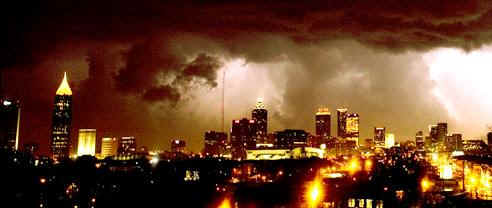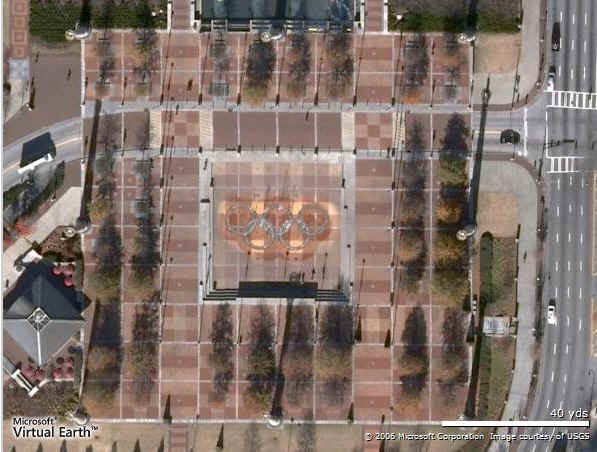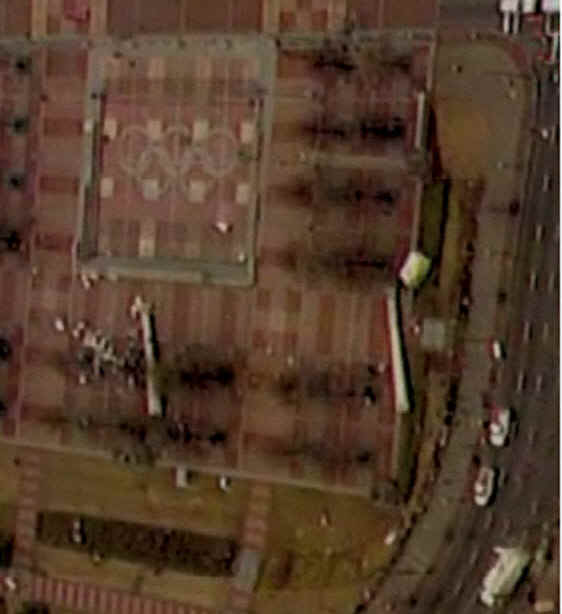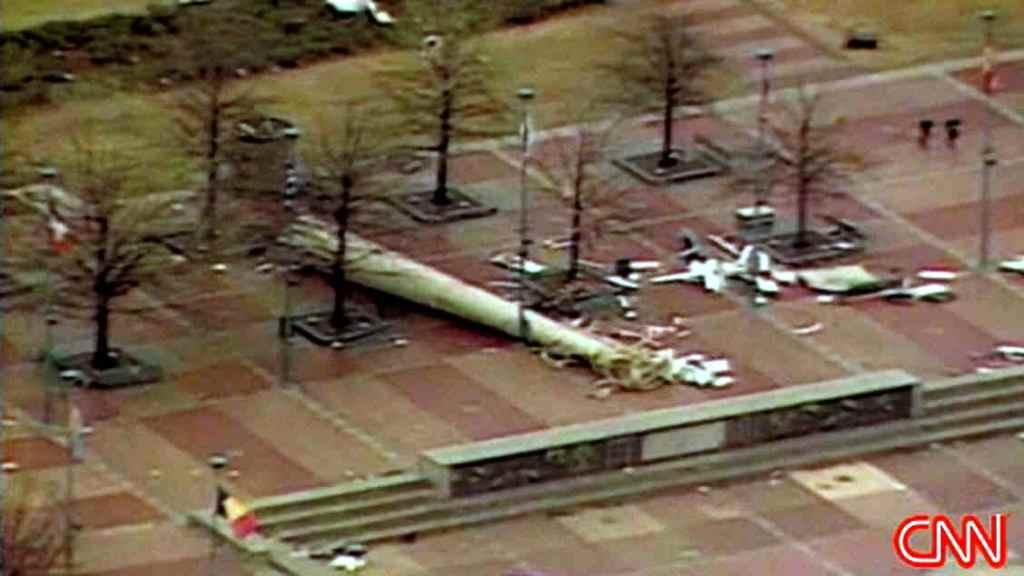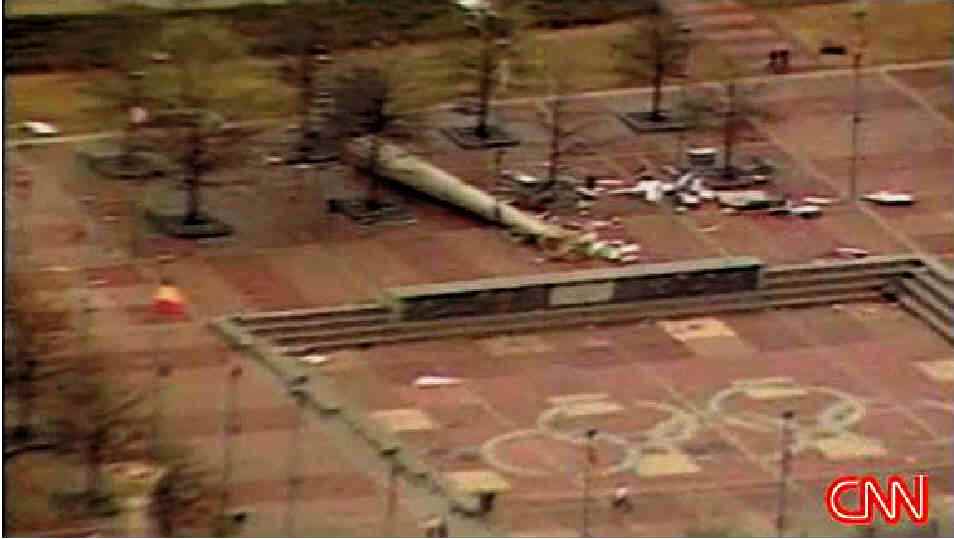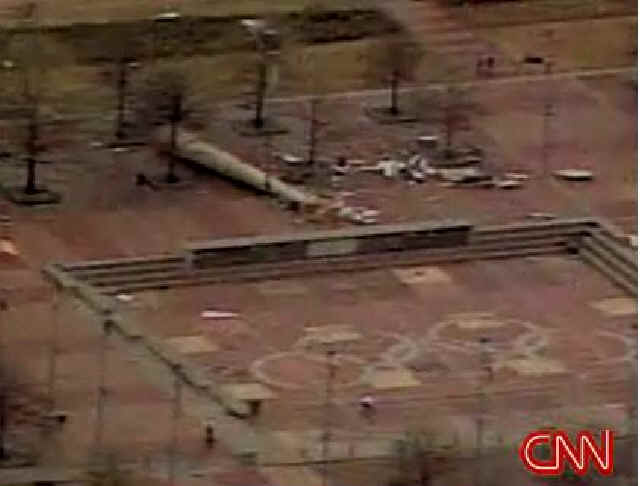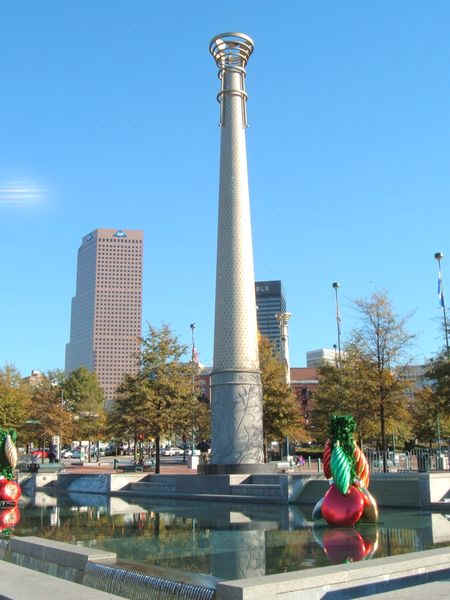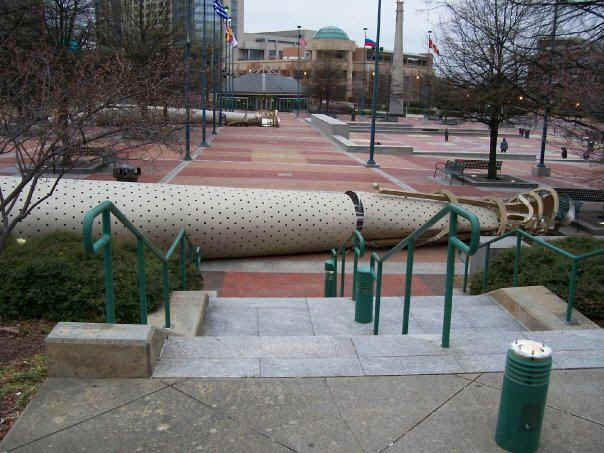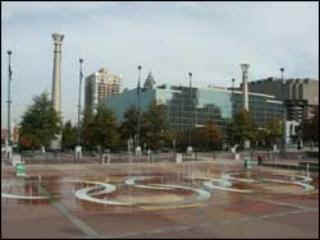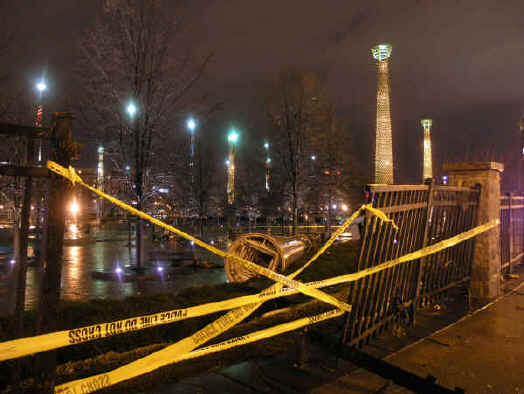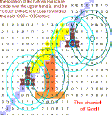An
isolated supercell developed in west-central Georgia in
the evening of March
14. An EF2 tornado was reported in downtown
Atlanta, which caused damage to several buildings, including the Georgia
Dome (while a SEC
Tournament basketball game was
underway), the World
Congress Center, Philips
Arena (during an Atlanta
Hawks game), and CNN
Center. Many windows were blown out of the Omni Hotel, which was
evacuated. A building collapse was also reported according to CNN coverage,
and at least nine people were injured (one critically)and there was
one reported death. Several buildings were also flooded. The
tornado was later confirmed as an EF2 on
the Enhanced Fujita Scale and had a path length of a about 6 miles
long and 200 yards wide and caused at least several millions of
dollars in damage.
On March
15, a moderate risk of
severe weather was issued for the same area, with more tornadoes
possible. At midday, the risk area was extended to the Carolina Coast. Later
that day, a high
risk was issued
for Northern Georgia and
part of South
Carolina. Several
tornadoes have been reported with fatalities and damage reported
across a swath from Alabama eastward.
A tornado emergency was
also issued on the afternoon of March 15 for Atlanta and its immediate
suburbs for a tornado that did not occur.
As
of March 16, all
severe weather watches and warnings have ended and moved off out into
the Atlantic Ocean.
===============
The
games had a profound impact on the city of Atlanta and
many in the Atlanta metro area consider the Games to be instrumental
in transforming Atlanta into the modernized city it has become. One
example of this modernization is the mid-rise dormitories built for
the Olympic Village. One of these complexes became the first
residential housing for Georgia
State University, and has recently been transferred for use by the Georgia
Institute of Technology. Other examples include Turner
Field, which was a modification of the original Centennial
Olympic Stadium, and where the Atlanta
Braves baseball team
now makes its home. Centennial
Olympic Park was also
built for the events and is still in use.
========
Some
felt Athens should have had the right to host the games because it
marked the 100th anniversary of the modern Olympic
games.[1] The IOC
instead voted, in 1990, for Atlanta, predicting that Athens' infrastructure could
not be improved enough in time to successfully host the Games. Athens
would
eventually win the right to host the 2004
Summer Olympics.
====================
http://www.baynews9.com/content/36/2008/3/15/332673.html
Tornado
confirmed in downtown Atlanta
Sunday,
March 16, 2008
ATLANTA,
Georgia (CNN) -- An
EF-2 tornado with winds up to 130 mph struck Atlanta Friday night,
leaving a trail of uprooted and broken trees, downed utility lines,
peeled-off roofs and collapsed brick walls marked the path of a
tornado that tore through downtown Atlanta.
Utility
and cleanup crews on Saturday worked to restore traffic lights, clear
streets and remove tons of debris in the city's business district
after Friday night's unusual urban storm.
At
least one person was killed Saturday as a dangerous line of
thunderstorms continued to prompt watches and warnings across northern
Georgia north of Atlanta, officials said.
The
fatality occurred near Aragon, Georgia, said Polk County dispatcher
Thomas Wilson. There are also unconfirmed reports of other fatalities
and of homes destroyed, he said.
Friday's
tornado plowed a path about 6 miles long and 200 yards wide.
The
twister appears to have first struck several houses and churches
west of the business district, then moved on to the Georgia
Dome,
CNN Center, Centennial
Olympic Park
and Cabbagetown.
A
brick apartment building west of the Dome was entirely roofless
Saturday morning.
Curtains
waved through broken windows high up the cylindrical 73-story Westin
Peachtree Plaza hotel.
Gaping holes were torn in the roof of the Georgia
World Congress Center,
and an auto parts warehouse just east of downtown partially collapsed.
Although
tens of thousands of people were in the path of the storm -- many in
town for a major college basketball tournament -- there were no known
deaths and just one life-threatening injury, police said.
About
30 people -- one of them a firefighter -- were treated at hospitals,
mostly for minor cuts, scrapes and bruises, police said.
The
American Red Cross reported about 70 people were using one shelter it
established, and a second was added later in the morning.
The
storm struck the 71,000-seat Georgia Dome at 9:45 p.m. during a
Southeastern Conference tournament basketball game. It shattered
windows and tore roofs from buildings -- including CNN Center --
before continuing into several residential neighborhoods.
Mahsud
Olufani, an Atlanta painter and sculptor with a studio in Cabbagetown,
said, "It looks like a bomb went off, it looks like World War
III."
A
large hole could be seen in the 14th floor of a high-rise dorm at Georgia
State University
in downtown Atlanta. Students were evacuated from the area on buses.
The
storm interrupted a Southeastern Conference game between Alabama and
Mississippi State.
"It
was actually in overtime, and the game was getting exciting, and I
thought people from the Alabama side were hitting the bleachers trying
to get some noise going," said basketball fan Lucas Shields.
"All of a sudden the TV went out, the overhead clock stopped
working, and you hear that distinctive noise of a train."
Amanda
Reimann, an iReporter and University of Georgia cheerleader, said she
and her teammates heard a loud noise.
"It
sounded like the fans were banging on the seats or stomping their
feet, but it kept up and got a lot louder," she said. "Then
the ceiling of the Dome started waving, the giant TV screens were
waving, and light fixures and dust started falling.
"My
teammates and I thought it was a bomb but our coach came running for
us and a security guy and said it was a tornado. We all ran for the
locker room."
The
game resumed about an hour later, but a later game between Kentucky
and Georgia was postponed.
A
professional basketball game at Philips Arena next door was not
disrupted, but the thousands attending that game also had to make
their way home through the storm debris.
Police
closed several streets in the vicinity of CNN Center because of glass
and other debris. Two
of Centennial Olympic Park's towering Olympic torches were toppled
and a performance pavilion was destroyed.
Inside
CNN Center, water poured through the damaged roof into the building's
atrium. Glass shattered, and parts of the building filled with dust.
Virtually
all of the windows
facing Centennial Olympic Park on the Omni Hotel,
which is adjacent to CNN Center, were shattered. Visitors to the hotel
were moved to the facility's exhibition hall at street level.
The
storm arrived with little forewarning. A tornado warning was issued
for the downtown area a few
minutes
before the storm hit. "Ironically, the guy behind me got a phone
call saying there was a tornado warning," said Lisa Lynn, who was
attending the game at the Georgia
Dome. "And in two seconds, we heard the noise and things started
to shake. It was creepy."
At Centennial
Olympic Park, located near CNN and the Omni Hotel,
two Olympic torch sculptures had fallen over,
and a performance pavilion was destroyed. A high-rise dorm at Georgia
State University was
damaged by the tornado, as evidenced by a large hole in the building's
14th floor. University students were evacuated on buses.
http://www.cnn.com/2008/US/03/14/storm.atlanta/index.html#cnnSTCText
-
ATLANTA,
Georgia (CNN) --
At least 20 homes in Atlanta's historic Cabbagetown neighborhood were
flattened by a tornado that ripped through downtown Atlanta on Friday
night, a spokeswoman for the mayor said.
Firefighters
fear there could be people dead inside the ruins of a collapsed loft
complex in the same neighborhood, the spokeswoman said.
There
have been no deaths confirmed from the tornado, but at least 15 people
were treated at two hospitals. Most of the injuries were minor cuts,
scrapes and bruises, officials said.
The
Fulton Cotton Mill Lofts, just east of downtown Atlanta, collapsed in
a "pancake fashion," Atlanta Fire Chief Kelvin Cochran said
early Saturday.
The
tornado that ripped through the heart of the city damaged the roof of
the Georgia Dome during a college basketball game, shattered windows
and ripped roofs from buildings before continuing into several
residential neighborhoods.
The
building that houses CNN was at the epicenter of the storm -- sitting
next to the dome and hotels where thousands of basketball fans
attending the Southeastern Conference tournament were at least
temporarily displaced.
"It
was actually in overtime, and the game was getting exciting, and I
thought people from the Alabama side were hitting the bleachers trying
to get some noise going," said Lucas Shields, who was attending
the game between Mississippi State and the University of Alabama.
"All
of a sudden the TV went out, the overhead clock stopped working, and
you hear that distinctive noise of a train."
Timothy
Wood, 30, of Cumming, Georgia, took refuge from rain at Philips Arena.
"First thing I saw were cups then I saw larger objects -- like
parts of Philips Arena were coming off and being blown into the
street," Wood said.
Police
closed several streets in the vicinity of CNN Center because of glass
and other debris from the storm.
The
storm tracked from the northwest side of the city to the southeast,
demolishing buildings and downing trees that crushed cars and ripped
through the roofs of homes.
At
the Fulton Cotton Mill Lofts, damage was extensive.
Mahsud
Olufani, an Atlanta painter and sculptor with a studio in one of the
other buildings, said he rushed to his studio when he saw news of the
damage.
"It
looks like a bomb went off, it looks like World War III," he
said. "It's a disaster area."
The
converted lofts also were the site of a massive 1999 fire, during
which a dramatic helicopter rescue was televised worldwide.
In
the neighborhood of East Atlanta, resident Cameron Beasley said he
could see four or five homes with storm damage, including trees
knocked through their roofs, and several cars crushed by downed trees.
"Something
really fierce came down," said Beasley, who said he and his wife
ran with their two children into their basement about 15 seconds
before the storm hit. "It was just crushing cars, crushing
houses."
The
National Weather Service had issued a tornado warning for the area, in
effect until 10 p.m. The storm came through at about 9:45 p.m.
Inside
CNN Center, water poured through damage in the ceiling into the
building's atrium. Glass shattered, and parts of the building filled
with dust.
Virtually
all of the windows facing Centennial Olympic Park on the Omni Hotel,
which is attached to CNN Center, were shattered, leaving curtains
flapping in the darkened windows. Visitors to the hotel were evacuated
to the facility's exhibition hall at street level.
Windows
also were shattered in the CNN.com newsroom, with staffers saying that
there was a computer missing -- apparently sucked through one of the
windows. CNN's library was also damaged.
Outside
the building, debris littered the streets and billboards collapsed
onto parked cars. Centennial Olympic Park was also severely damaged.
Next
door at the Georgia Dome, the Alabama-Mississippi State game was
halted. The storm visibly rippled the ceiling of the dome and caused
some damage, video of the arena showed. Scaffolding holding the
facility's scoreboard swayed 15 minutes after the storm hit.
The
game resumed about an hour later, but a later game between Kentucky
and Georgia was postponed.
Joe
Bryson, 28, of Cumming, Georgia, was outside when the winds hit.
"When
it started to drizzle a little bit, everyone got under some shelter,
watching things develop. It started to pick up a bit. When the metal
barriers fell over and started skidding along the ground that's when
everyone started -- not panicking -- but going inside.
"I
saw two fellas who were running to come to shelter and they were
getting pushed from the back [by the wind]. They got knocked down but
got right back up and followed everyone inside," Bryson said.
Catherine
Niehaus, an iReporter, was inside the Georgia Dome when she said the
roof split, scaffolding slipped and the scoreboard started to sway.
Slabs
of metal and insulation material smothered the streets outside. Cars
and emergency vehicles were scattered among the debris as hundreds of
people, many of them attending the Southeastern Conference basketball
tournament, wandered around talking on cell phones.
Heaps
of bricks and sheetrock were pushed up against cars. Streets signs
were bent in half.
At
the neighboring Georgia World Congress Center, the storm blew down a
wall, allowing water to pool ankle deep inside the building.
Further
east, heavy damage was reported near Grady Memorial Hospital.
According
to the National Oceanic and Atmospheric Administration, the most
recent downtown tornado in the United States hit Jacksonville,
Florida, August 12, 2004. There were no deaths.
According
to the NOAA, the deadliest tornado to hit a downtown area in the 20th
century was May 11, 1953, when 114 people were killed in Waco, Texas.
Although
downtown tornadoes are rare, it's a misconception they can't happen,
according to The Tornado Project, a company that gathers and compiles
tornado information. "That more 'cities' aren't struck by
tornadoes is probably more coincidence than anything else,"
according to the project's Web site.
"There
are very few 'big cities' with skyscrapers in Tornado Alley. In fact,
there are only a dozen, and one of them, St. Louis, Missouri, has a
long history of tornadoes in its central area."
=============
Atlanta
tornado event
In
their 9:00 pm EDT outlook, the Storm
Prediction Center issued
a slight risk of severe weather across portions of the southern
United States from Oklahoma to Georgia,
with a 2% risk are for tornadoes for the Atlanta area. A tornado
warning was issued
for Atlanta at 9:26 pm when the thunderstorm that
caused the tornado was 6 miles (10 km) to the west of
downtown, although no watches were in effect for the area due to the
low probability and isolated nature of the storms.
A
news conference held on March
15 confirmed that
the tornado was a high-end EF2 tornado
on the Enhanced
Fujita scale. It touched down in the Vine
City neighborhood of
Atlanta, moving east-southeast into downtown as an EF1, and then
strengthening into the Cabbagetown neighborhood,
and into East
Atlanta. It had a
path length of about 6 mi (9.7 km) and was about 200 yd
(180 m) wide
The
direction of the storm was unusual, drifting southward as it moved
eastward, whereas most tornadic storms have a strong northward
component along (or ahead of) a cold
front. It also was unusual because it was not associated with such a squall
line at all, but was
an independent supercell drifting
well ahead of the main storm system.
March
15 tornado event
Another
tornado outbreak struck the southeast the following day. A moderate risk
for severe storms was issued early in the morning, and maintained
through the afternoon.
However,
by mid afternoon, areas of east-central Georgia and central South
Carolina were upgraded to a high
risk of severe
storms due to the tornado threat.
http://en.wikipedia.org/wiki/Centennial_Olympic_Park
- ===========================================
Georgia
Dome
Main
article: 2008 Atlanta
tornado outbreak
